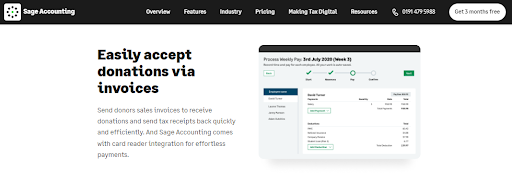Do you ever feel that your nonprofit could be doing more?
Of course, you know your hard work is for a good cause, but do you ever wonder what else you could do to improve your reach? But what if you could reach twice as many people and double your effectiveness?
It’s time to talk about digital marketing. In this post, we'll explore how you can leverage an effective content marketing strategy to ensure your message reaches as many people as possible. In particular, we’ll look at eight best practices you can follow to get superb results.
The importance of digital marketing for nonprofit organizations
Many smaller nonprofits still rely on traditional forms of marketing like mailers and information stalls. There’s nothing inherently wrong with using those kinds of approaches. Face-to-face interaction can be essential to successful marketing for nonprofits since it focuses on the human connection, which nonprofit organizations usually rely on.
That said, if you’re not investing in modern content creation platforms, you’re missing out on a great and cost-effective way to create engaging marketing collateral at scale that will spread awareness of your work.
With best-practice digital marketing strategies, you can get your message out much further, much faster. Some of the prime benefits include:
- Increased fundraising potential
- Higher chance of long-term support from donors
- Boosted awareness of your cause and services
- Reach the right audience in the right channel
The message is clear: if you want to maximize your nonprofit’s effectiveness, you need to impress your readers with modern design tools that will enhance the performance of your campaigns.
8 best practices in nonprofit digital marketing
Before we dive in, it’s worth noting there’s no single correct way to go about marketing your nonprofit. But, if you follow these eight top tips, you won’t go far wrong.

Maintain a cohesive message and branding
If your nonprofit doesn’t yet have an instantly recognizable logo, it’s time to create one. A logo is the most visible part of your brand identity, and having an eye-catching design is the first step to getting noticed. It’s also essential to ensure you have a consistent visual identity that appears on all of your digital assets, such as your website and digital documents.
Creating an instantly recognizable brand is the first step. This is how you’ll get people’s attention and keep it as you continue to promote your cause. But, after this, what is most important is to create a message that is impactful and consistent.
To achieve this, a core mission statement clearly states your values and goals is a good idea. Then, you can continue to refer to this mission statement and values throughout your marketing campaigns and online content.
Not only will this present a clear and strong message that will be easy for new audiences to grasp, but it will also help bolster your credibility as you demonstrate your commitment as a nonprofit.
To help with this, you can create a brand guide that includes aspects of your brand, such as the tone of voice, color schemes, and values. This will enable everyone in your organization to stay on the same page.
For example, look at the example below from the WWF brand book. By focusing on the message they want to convey, they have created a solid and cohesive brand identity that is globally recognizable.

Interactive content creation platforms make brand governance a walk in the park once you upload your brand guide to the platform, ensuring that everyone in your team can create impactful, on-brand content at scale.
Check out our 7 tips for Spotless Content Governance.
Promote your achievements
Use data-driven storytelling to support your claims, engage your audience, and build trust. Let’s say your nonprofit focuses on organizing respite breaks for family members who have caring responsibilities in the home. You use these projects to create excellent case studies that showcase your work.
But it’s also a good idea to dig deeper into the stats. How many people currently care for a family member at home? Is this a growing trend? Why? How many more families have you helped this year than last year? In what ways? Ground your stories and achievements in facts and figures. It’s a much more effective way of engaging readers than relying on a narrative alone.
Of course, these types of case studies aren’t always readily available. As a nonprofit, you’re likely to be cautious regarding data protection, especially if you’re working with vulnerable people. So, another option you should also consider is leveraging testimonials from partners.
Maybe you partnered with another organization to carry out a big project, or a local company recently decided to donate significantly. These are also outstanding achievements that you can promote through testimonials and quotes from these partner organizations, demonstrating your work and the impact your nonprofit is having.
Reduce costs and find support
As a nonprofit, costs will always be important. So, when it comes to digital marketing, you want to ensure you’re getting the most bang for your buck and taking advantage of the wealth of schemes.
So, do your research and see what assistance is available. For example, reach out to larger marketing companies, as many of them, such as GroupM and Publicis, offer pro-bono campaigns. Similarly, by getting verified by Percent, you can access several online services, such as Canva and Google Ads, for free.
Where you invest in your marketing, you should look into which of your costs are tax-deductible depending on where you are based. In the US, 501(c)(3) organizations can deduct the cost of marketing materials and ad campaigns directly related to their core work.
Similarly, digital advertising for charities in the UK qualifies for zero-rating VAT relief. To help with this, UK nonprofits should look into Making Tax Digital software and how it can simplify compliance and claiming back tax.
Consider researching a web-based content creation platform that removes design bottlenecks and reduces reliance on external agencies to create digital marketing collateral. You can improve your content creation process by empowering people in your team to create content independently - whether they’re designers or not.
Discover: How to Successfully Scale Content Production
Equip your team with the right tools
To start with, you’ll need to have the essential digital tools in place:
- A well-structured and engaging website
- An email marketing program
- Regularly updated social media accounts
If possible, it’s best to have at least three people responsible for the digital side of your operation. The more, the better — but that’s not always realistic, particularly for smaller nonprofits.
The crucial thing is to maintain regular messaging. This doesn’t mean emailing your list twice daily; that’s likely to annoy many supporters, who may unsubscribe. One email per week is plenty. Make sure you post at least twice a week with social media accounts. The site algorithms may punish any less than that and your content. In turn, that will reduce your reach rather than increase it.
Moving to the next stage is a good idea if you have the capacity. That means using search engine marketing (SEM) and optimization (SEO) tools to increase your content’s visibility. This will necessitate training for your team, but the results will be worth it.
Use the right imagery and content
You’ve established your branding and messaging. Now, it’s time to go one step further and consider how to tailor your digital marketing strategies to each platform or audience you’re appealing to.
Start by considering the different types of content out there. You don’t have to stick to emails and social media posts. Why not experiment with videos or podcasts? These can bring you to the attention of a whole new audience if done well.
Next, remember that not all imagery or content is suitable for every task. For example, Instagram is a primarily visual medium. It wouldn’t be the appropriate platform for a long piece of text. On top of that, consider how your imagery aligns with your overall campaign goals.
Take Amnesty International, for example. They use impactful and sometimes shocking images when they’re trying to raise awareness about an issue. However, when their campaign is more focused on donations, they use simple visuals and statistics to demonstrate to potential donors how their money will be used, creating a feeling of transparency.

Join Google for nonprofits
The digital behemoth Google supports nonprofits with a special deal. It makes its Google Workspace suite free to any nonprofit organization with up to 2,000 users. You can use professional software such as Gmail, Docs, Sheets, Drive, Chat, etc. The deal includes:
- Email addresses for everyone, incorporating your nonprofit’s domain name (e.g., jenny@[name of your nonprofit].org rather than jenny[nonprofit]@gmail.com — it just looks slicker)
- Video meetings for up to 100 participants
- 30 GB of cloud storage for each individual
- Security and management control tools
- Standard customer support
It’s an excellent package and a straightforward way to unify all your brand messaging. The fact it’s completely free is a fantastic bonus.
Track your lead generation thoroughly
Monitoring the performance of your digital marketing campaign is an integral part of the process. At the planning stage, you should set up lead generation KPIs that you’ll target. The point of this is to measure just how effective your content is.
Stats such as how much traffic is going to your website are interesting in their own way. But they don’t tell the whole story. The essence of lead generation is valuable and engaging content. You can measure this in several ways, including:
- How long do people spend reading or consuming your content
- Which topics tend to attract the most views
- For written content, how many pages people read on average
- If you have interactive elements on your website, like videos or quizzes, which ones do visitors engage with the most?
A granular look at how your content performs helps you do better next time. It’s important to remember that all digital marketing is an iterative process. You experiment, measure results, and then feed the insights gained into the beginning of the next creation cycle.
Choose a donation platform that works with your campaign
There’s a massive range of donation platforms available nowadays. This includes well-known dedicated sites such as JustGiving or GoFundMe. But you’ll also find donation functionality as part of more general payment tools like Stripe.
It’s worth considering how often you hope your donors will also give. Will most donations be one-off transactions, or are you aiming to encourage giving on an ongoing basis?
With the right accounting software for charities in place, you can also accept donations via invoices. That can make your nonprofit a more appealing prospect to more significant donors such as corporations.

Whatever platform you choose, make sure it’s easy to use for your target audience. Any standard platforms will work if your nonprofit is a small organization focusing on your local community. That said, if you are a larger nonprofit hoping to appeal to international donors, you must be careful to offer various options. Venmo, for example, can only be used in the US, so that it would be a poor choice.
Supercharge your reach with digital marketing
No doubt, getting serious about digital marketing can have a massive impact on your nonprofit’s success. If you want to increase your reach and attract new donors, volunteers, and other stakeholders, there’s nothing to match it.
It takes careful planning, a few digital tools, and the right mindset. Before you know it, you’ll be well on your way to making an even more significant difference than before. And that’s what it’s all about, right?


